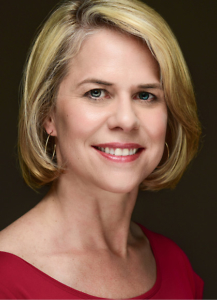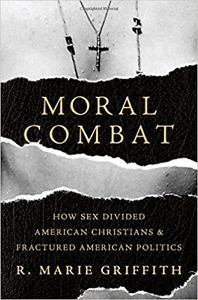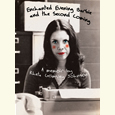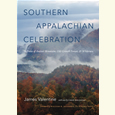Sex, God, and Politics
By recounting historic debates over sex and morality, R. Marie Griffith explains our political divides
FROM THE CHAPTER 16 ARCHIVE: This interview originally appeared on December 7, 2017.
***
Why can’t we all just get along? How have we become so politically divided? In Moral Combat: How Sex Divided American Christians and Fractured American Politics, R. Marie Griffith argues that the answer lies, in part, in diverging religious ideas about sex and morality.

Griffith, who grew up in Chattanooga, is a distinguished professor in the humanities at Washington University in St. Louis and the author of books that include God’s Daughters: Evangelical Women and the Power of Submission and Born Again Bodies: Flesh and Spirit in American Christianity. She is also director of the John C. Danforth Center on Religion and Politics and editor of the Center’s journal, Religion & Politics. She answered questions from Chapter 16 via email.
Chapter 16: By the time of the Supreme Court’s 2015 Obergefell v. Hodges decision, which declared same-sex marriage a constitutional right, you state that “one could plausibly argue that American Christianity had split into two virtually nonoverlapping religions.” How so? How were these religious strains rooted in ideas about sex?
R. Marie Griffith: Christians have fought over sexual freedom since Margaret Sanger’s birth-control movement, which pitted Catholic leaders who opposed contraception against Protestants who argued that married couples should be free to limit the size of their families as they chose. Subsequent debates over issues such as obscenity and censorship, interracial marriage, sex education, abortion, and homosexuality deepened the divisions between those Christians (conservative Catholics now joined by conservative Protestants) who wanted to hold on to an older sexual order and those (liberal Protestants now joined by liberal Catholics) who embraced changes to that order that they did not consider threatening to their faith.
The split reaction to Obergefell epitomized this fracture: Christian leaders on the right responded as if the decision were a rejection of God’s will that marked the end of civilization, while religious leaders on the left hailed it as a righteous fulfillment of Jesus’s call to justice. The very meaning of morality has been split, in fact, leading us into what Michael Gerson recently called “tribal morality,” although I don’t think it’s merely politics: Christians in these two camps deeply disagree about the centrality of virginity and sexual purity to the core of the Christian message, and by now there seems to be astonishingly little in common between these two worldviews.
Chapter 16: In the nineteenth century, there was a general consensus, both religious and moral, about sexual behavior, gender roles, and marriage. What was that consensus? Why did it later break apart?
Griffith: Until the early twentieth century, most Americans believed that sexual morality consists of a system of values that must be guarded and preserved for the greater social good as well as for one’s personal salvation. While people disagreed about any number of issues—slavery, states’ rights, labor laws, alcohol use, etc.—most believed in, and took for granted as natural and divinely ordained, a sexual order in which men were heads of households, wives must submit to husbands’ authority, and monogamous heterosexual marriage was the only proper site for sexual relations. Those who broke the rules were punished or shunned.
The modern women’s rights movement—above all the push for women’s right to vote—prompted a crisis for those shared assumptions. Many advocates of feminism and suffrage were imagining less hierarchical marriage structures, as well as greater freedom for sex outside of marriage.
 Chapter 16: At the dawn of the Cold War, Alfred Kinsey’s pioneering books on human sexuality ignited a cultural and political debate about American morals. How was it also a religious debate?
Chapter 16: At the dawn of the Cold War, Alfred Kinsey’s pioneering books on human sexuality ignited a cultural and political debate about American morals. How was it also a religious debate?
Griffith: Christian leaders were quite split in their reactions to Kinsey’s 1948 report, Sexual Behavior in the Human Male, and still more divided over his 1953 report, Sexual Behavior in the Human Female. Catholic and conservative Protestant leaders expressed revulsion at Kinsey’s claim that both men and women had far more sexual experience (including same-sex relations and sex outside of marriage) than contemporary moral norms deemed respectable. The conservatives asserted that Kinsey was lying in order to promote a sexual revolution and condemned him for insulting the purity and virtue of American women.
Christian leaders in more liberal and mainline Protestant contexts weren’t exactly delighted with Kinsey’s claims but they appreciated his frankness in dealing with difficult topics, and they sought to develop a pastoral response to show greater compassion to those who lived in shame because of their sexual struggles. These divergent responses also characterized many church members and sometimes erupted in open conflict.
Chapter 16: One of the dominant trends in modern American politics is the rise of the “Christian Right.” How did conservative religious ideas about sexual order fuel this movement?
Griffith: In many ways, the “Christian Right” was in the making as early as the 1920s, amidst the fight over birth control. It took a big leap forward in the 1960s, thanks to the activism of fundamentalist leaders such as Billy James Hargis and the fight against sex education in the public schools. Parents and church people across the nation, in both Catholic and conservative Protestant circles, were galvanized at that time by shocking claims of the corrupting influence of sex educators like Mary Steichen Calderone, whom they believed was trying to foment debauchery among American youth for Communist ends.
Those constituencies evolved and expanded in the 1970s and 1980s, as leaders such as Phyllis Schlafly, Tim and Beverly LaHaye, Anita Bryant, and Jerry Falwell galvanized large numbers of people by painting terrifying scenarios of the ills supposedly wrought by feminism, sexual freedom (including the freedom to date across racial lines), homosexuality, and abortion. What all of these issues seemed to have in common was the capacity to undermine and destroy “traditional family values”—that is, the hierarchical marriage structure (husbands ruling wives) and the strict sexual norms I outlined earlier. So the determination to protect and conserve these values provided crucial impetus to the Christian Right’s explosive growth in those years and beyond.
Chapter 16: When discussing historical debates about issues such as sexual behavior and abortion, we tend to see the liberal side as secular. Yet Moral Combat illustrates the religious dimensions to these arguments. What can we learn from highlighting figures such as Mary Steichen Calderone and Howard Moody?
Griffith: Some of the people pushing hard for reforms in American ways of thinking and talking about sex, or even for revolutions in sexual morality, have strongly identified with religious principles and parish communities. In fact, they repeatedly made clear that their commitment to what they saw as a more sexually honest and compassionate world stemmed directly from religious values.
Calderone was a devout Quaker whose strong faith incentivized her to work for greater openness in sex education, and she garnered tremendous (and quite vicious) opposition from fundamentalist Christians such as Hargis. Moody was a Baptist minister (originally Southern Baptist) whose commitment to Jesus’s commands led him to service and advocacy work for prostitutes and for desperate women seeking safe abortions when the procedure was illegal.
Leaders like these held a lot in common with their more secular counterparts, and their enemies have sometimes discounted their religiousness as a ruse, just as today’s progressive Christian leaders are regularly accused of distorting the faith for political ends. But religious progressives have mattered a great deal more in progressive political movements than we’ve often thought, and it’s wrong to treat their “religiousness” as spurious or immaterial.
Chapter 16: In the 1990s, there were two flashpoints in terms of national awareness of sexual harassment: the Anita Hill accusation during confirmation hearings for Clarence Thomas, and the lawsuit by Paula Jones against Bill Clinton. What were the similarities and differences in the debates over these instances? What might they reveal about the nation’s religious, cultural, and political divides?
Griffith: The two cases are very different in terms of the substance of the accusations and much else. But the clear similarity between them is in the broader American public’s reaction to them: in both cases, people’s moral outrage followed their politics. Onlookers’ reactions to the key characters in these stories did not seem to rely on deep investigation of the “facts” on the ground; the reactions were grounded more in gut instinct about who was telling the truth and the political consequences resting on the outcomes of these cases. I think this is an important lesson for all of us, particularly in this current moment of manic polarization and tribal politics. We often blame our political enemies for being primed to believe or disbelieve a story depending on the politics of who is telling it, but we don’t always see our own inclination to do likewise.
Of course, there’s always the chance that a person could believe a specific story about a man harassing or assaulting a woman and support that person anyway, as we saw among people who revered Clinton despite the many credible accusations against him, and as we’re seeing today among those Americans who continue to support credibly accused men like Donald Trump and Roy Moore. We’re in a context now where we can see that one of our key divisions is between those who believe that sexual harassment and assault are appalling abuses of power and those who just don’t seem to care that much, so long as their own side wins. That might be our saddest division of all.
 Aram Goudsouzian chairs the history department at the University of Memphis. His most recent book is Down to the Crossroads: Civil Rights, Black Power, and the Meredith March Against Fear.
Aram Goudsouzian chairs the history department at the University of Memphis. His most recent book is Down to the Crossroads: Civil Rights, Black Power, and the Meredith March Against Fear.





